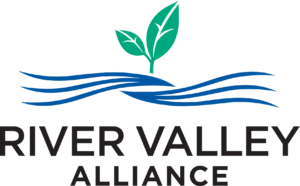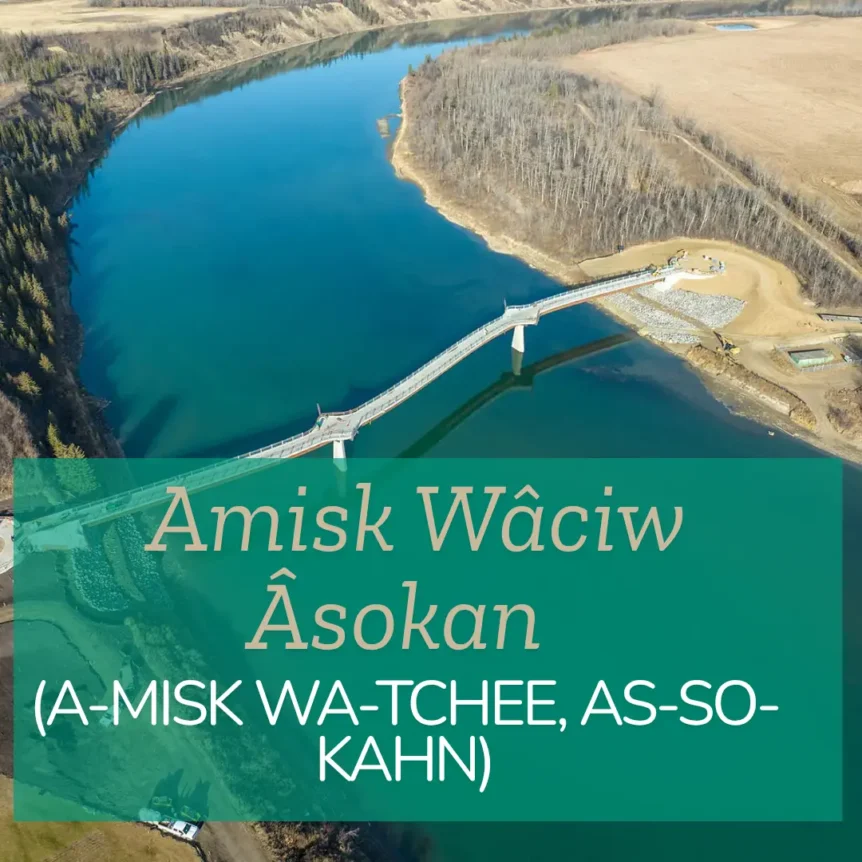Why Indigenous Names Matter: Honouring Language and Building Reconciliation
With the opening of the new pedestrian bridge connecting Edmonton and Strathcona County, we’ve heard plenty of excitement about this incredible new link, the Amisk Wâciw Âsokan (pronounced a-misk wa-tchee, as-so-kahn) — part of the Amisk Wacîw Mêskanaw (Beaver Hill Road Trail). This connection makes our river valley trail network more complete than ever — and will be used and loved for generations.
But we’ve also heard some feedback: some community members find the bridge’s name — Amisk Wâciw Âsokan (a-misk wa-tchee, as-so-kahn) — challenging to pronounce or unfamiliar. And that’s okay — learning new words, especially in a language you may not have encountered before, takes time.
This name, which means “Beaver Hill Bridge” in Cree, was shared with us by Elder Jerry Saddleback. It ties the bridge to the long history of this place and honours the Indigenous Peoples whose footsteps marked these trails long before Edmonton and Strathcona County existed.
This is why naming projects in Indigenous languages matters, and why we believe it’s an important act of reconciliation.
Language as a Living Connection
Indigenous languages hold history, culture, and teachings within them. Each name often reflects the geography, the animals, the plants, or the spirit of a place.
By calling this bridge Amisk Wâciw Âsokan (a-misk wa-tchee, as-so-kahn), we are doing more than just naming a piece of infrastructure. We are keeping alive the stories that connect us to the land and to generations who came before us.
Pronunciation as Practice
It’s okay if you stumble over the name the first few times — many of us do! Taking the time to learn how to pronounce Amisk Wâciw Âsokan (a-misk wa-tchee, as-so-kahn) is a small but meaningful act of respect.
Just like learning to say someone’s name correctly, pronouncing Indigenous place names honours the language and the people it represents. Every time you see this name — Amisk Wâciw Âsokan (a-misk wa-tchee, as-so-kahn) — try saying it out loud. It will feel more natural each time.
“Only 1% Will Know How to Say It”
Some people have said that because few people know how to say Amisk Wâciw Âsokan (a-misk wa-tchee, as-so-kahn), we shouldn’t use the name. But that’s exactly why it’s so important.
For generations, Indigenous languages were deliberately suppressed. By using names like this in public spaces, we create opportunities for everyone to learn them — turning that “1%” into 10%, 50%, and eventually the whole community.
It’s not about perfection, it’s about practice. Every time you cross Amisk Wâciw Âsokan (a-misk wa-tchee, as-so-kahn), say its name. Soon it will feel as natural as saying “Terwillegar,” “Kaskitayo,” or “Whitemud.”
Naming as Reconciliation
The Truth and Reconciliation Commission’s Calls to Action encourage us to integrate Indigenous languages into public spaces. Using Indigenous place names like Amisk Wâciw Âsokan (a-misk wa-tchee, as-so-kahn) is one way we can make reconciliation visible — not just in policies and plans, but in the way we interact with the land every day.
By naming bridges, trails, and landmarks in Indigenous languages, we are:
- Recognizing that these lands have deep, pre-colonial histories
- Respecting the languages that residential schools tried to erase
- Creating opportunities for all of us to learn, reflect, and grow
How You Can Take Part
- Practice the Name: Say it aloud — “Amisk Wâciw Âsokan (a-misk wa-tchee, as-so-kahn).”
- Share the Story: Tell friends and family about Elder Jerry Saddleback’s contribution in naming the bridge.
- Reflect on the Land: Remember that reconciliation isn’t a one-time event — it’s an ongoing commitment to respect, relationship, and restoration.
By embracing names like Amisk Wâciw Âsokan (a-misk wa-tchee, as-so-kahn) — even when they feel new or challenging — we create space for language, culture, and community to thrive. And that’s exactly what this bridge is about: connection.
Let’s walk across it together, in every sense of the word.

